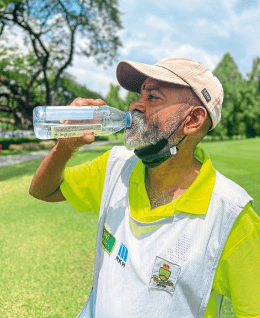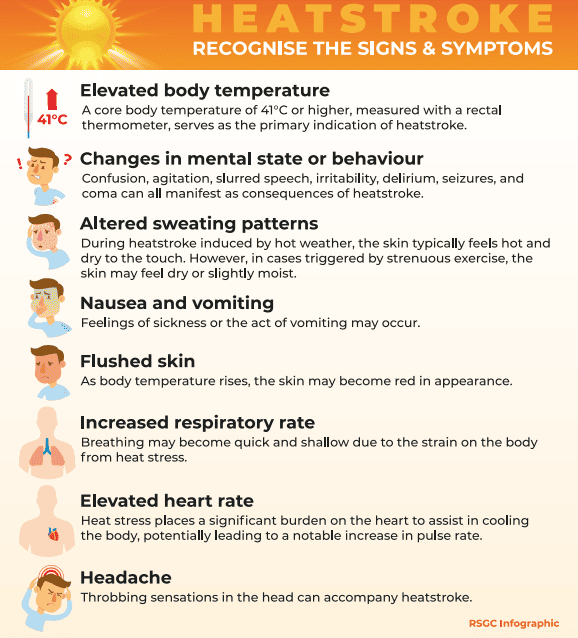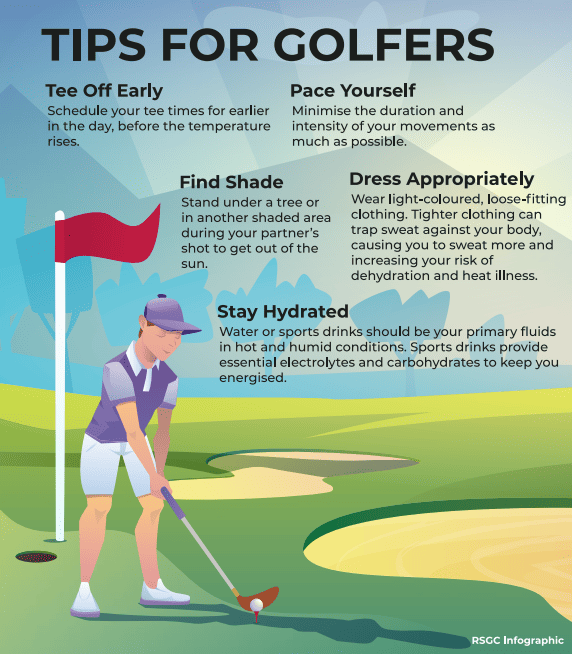Members, it’s time to tune in! Heat alerts are a must-know for a safe and enjoyable round of golf or tennis. Let’s delve into what heat stroke is and uncover essential tips to keep you cool and safe while playing your game.
Heat stroke is a severe condition characterised by an elevated core body temperature exceeding 41°C and central nervous system dysfunction, which can lead to delirium, convulsions, or coma. It is a life-threatening illness and requires prompt medical attention.
RECOGNISE THE SIGNS AND SYMPTOMS
The signs and symptoms of heatrelated health issues can vary in severity, necessitating the ability to identify potential indicators accurately. Symptoms of heat stroke include those typical of milder heatrelated illnesses such as muscle cramps and heat exhaustion, along with neurologic abnormalities like confusion, delirium, or seizures.
It’s crucial to recognise these signs and symptoms promptly, especially during periods of high temperatures or strenuous activities, and seek immediate medical attention if heatstroke is suspected.
WHAT DO YOU DO WHEN YOUR GOLFING COMPANION EXPERIENCES HEATSTROKE?
Treatment for heat stroke involves immediate cooling of the body and supportive care. First aid measures include moving your companion to a cool environment, removing excess clothing, and applying cold packs or spraying cool water to lower body temperature. Replace fluid loss by rehydration salt drinks, or where possible IV drip. Additionally, applying ice packs or cooling towels soaked in cold water over the neck, groin, and, armpits helps lower body temperature. It’s crucial to act swiftly in these situations; therefore, immediately call 999 to request assistance from ambulance services and paramedics if these symptoms arise.
Members who spend several hours on the course on a hot day face an increased risk of elevated body temperature, dehydration, and heat-related illnesses, which can impair both their performance and overall health. You can mitigate these risks by following these tips:
CARE OF YOUR CADDIE
To assist your caddie in avoiding heat stroke, ensure they have access to plenty of water and encourage them to drink regularly throughout the day, even if they don’t feel thirsty. Encourage the use of high SPF sunscreen to safeguard their skin from harmful UV rays, reducing the risk of sunburn and related heat issues.
Schedule regular breaks in shaded areas to allow them to rest and cool down, especially during peak sun hours. Monitor your caddie for any signs of heatrelated illness, such as dizziness, excessive sweating, or nausea. If they show any of these symptoms, suggest they seek medical attention immediately.
If possible, arrange tee times during the cooler parts of the day, such as early morning or late afternoon, to avoid the hottest periods around midday. By following these steps, you can help ensure your caddie stays safe and comfortable, reducing the risk of heatstroke while on the course.
han cure. By being mindful of the risks and taking proactive measures, you can safely enjoy your game without compromising your well-being. So, the next time you’re playing golf, recognise all the symptoms and take appropriate action to stay safe and healthy






